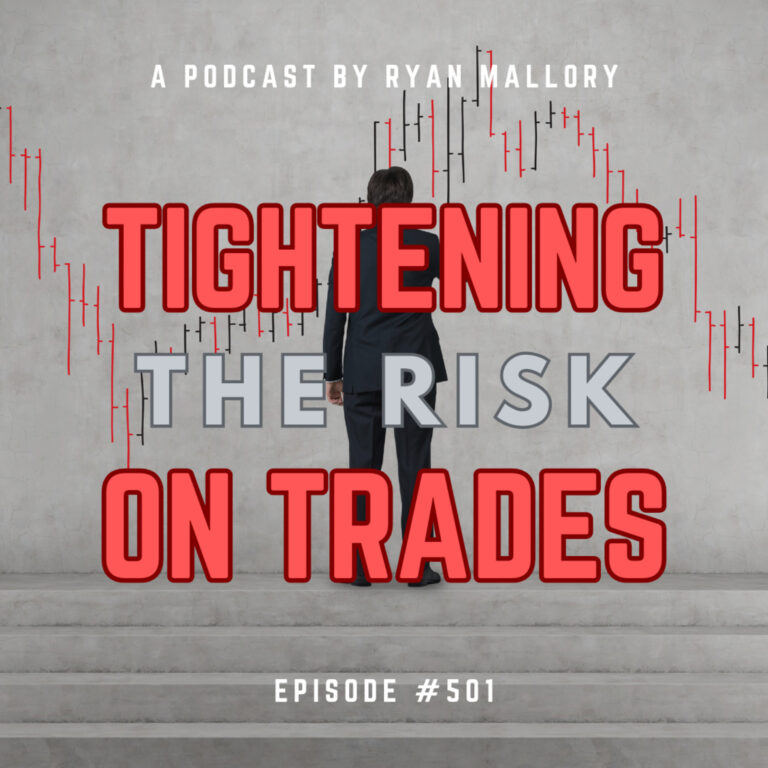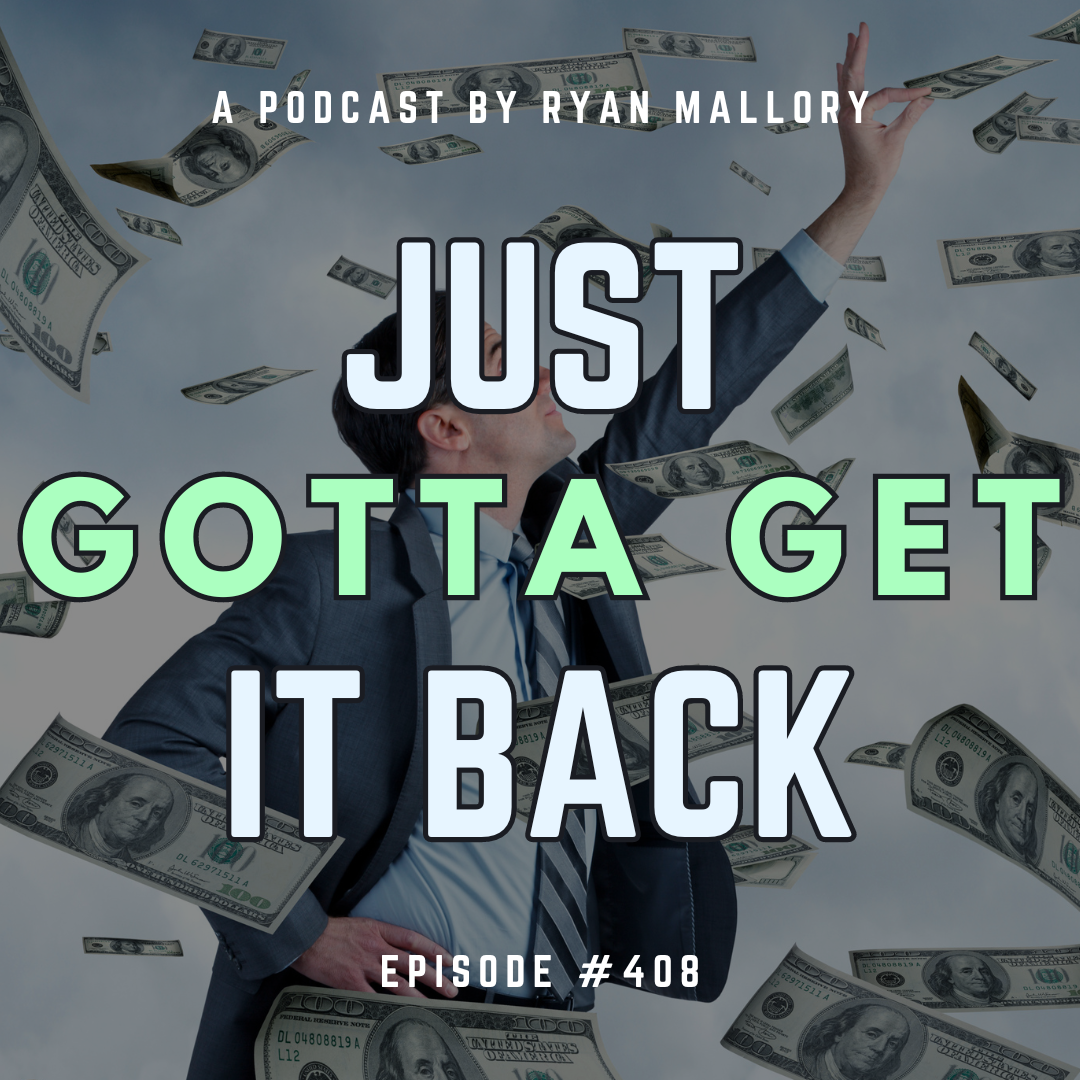Episode Overview
One of the biggest mistakes that swing traders make is the desperate attempt to get back what they once had in their trading accounts. In this podcast episode, Ryan explains how this kind of move can lead to some disastrous results for your trading and how it is imperative that you accept where you are at right now.
Available on: Apple Podcasts | Spotify | Amazon | YouTube
Episode Highlights & Timestamps
- [0:40] The Emotional Trap of “Getting It Back”
Ryan introduces the idea that many traders fall into the mindset of trying to recover previous gains, which often leads to poor trading decisions. - [4:06] A Lesson from Indiana Jones
Ryan shares a scene from “Indiana Jones and the Last Crusade” that perfectly illustrates the danger of reaching for what was just lost instead of letting go. - [7:07] The Problem with Doubling Down
He explains how doubling down on a losing trade may feel logical in the moment but typically results in increased risk and deeper losses. - [8:47] Seeing Wins and Losses as Just Trades
Ryan emphasizes that the healthiest perspective in trading comes from viewing every trade as routine, without emotional attachment to the outcome. - [11:10] Why Early Trading Success Can Be Dangerous
Ryan explains that early success can reinforce bad habits and lead to future mistakes if traders believe their methods are effective when they are not.
Key Takeaways from This Episode:
- Letting Go is Critical: Sometimes the best decision is to walk away from a losing trade rather than reaching to reclaim what was lost.
- Avoid Revenge Trading: Trying to recover previous losses often results in emotional decisions that make the situation worse.
- Stick to Discipline, Not Hope: Hoping a losing trade will turn around is not a strategy. Following a pre-set plan is essential.
- Trading Should Be Routine: Seeing each trade as routine helps avoid emotional highs and lows that can interfere with consistency.
- Losing Early Can Be Beneficial: A loss early in your trading career can be one of the most important lessons, helping you develop discipline and a better understanding of risk.
Resources & Links Mentioned:
- Swing Trading the Stock Market – Daily market analysis, trade setups, and insights by Ryan Mallory.
- Join the SharePlanner Trading Block – Get real-time trade alerts and community support.

Take the Next Step:
✅ Stay Connected: Subscribe to Ryan’s newsletter to get free access to Ryan’s Swing Trading Resource Library, along with receiving actionable swing trading strategies and risk management tips delivered straight to your inbox.
📈 Level Up Your Trading: Ready for structured training? Enroll in Ryan’s Swing Trading Mastery Course, The Self-Made Trader, and get the complete trading course, from the foundational elements of trading to advanced setups and profitable strategies.
📲 Join the Trading Community: Sign up for SharePlanner’s Trading Block to become part of Ryan’s swing-trading community, which includes all of Ryan’s real-time swing trades and live market analysis.
Full Episode Transcript
Click here to read the full transcript
0:07
Hey, I’m Ryan Mallory and this is my Swing Trading the Stock Market podcast. I’m here to teach you how to trade in a complex, ever changing world of finance.
0:16
Learn what it means to trade profitably and consistently, managing risk, avoiding the pitfalls of trading, and most importantly, to let those winners run wild.
0:25
You can succeed at the stock market and I’m ready to show you how. Hey everybody, this is Ryan Mallory with Swing Trading the Stock Market.
0:34
In today’s episode, I’m calling it, Just got to get it back. What do I mean by that?
0:40
I mean, far too often as traders, we think about what we had and what do we have to do to get it back.
0:47
And that usually leads to some of the worst trading decisions that we can possibly make. So today’s e-mail comes from a guy that we’ll call Elrod, Good Florida Redneck name because we do not use their real identities and Elrod writes Hey Ryan.
1:06
I’ve been a listener of your swing trading podcast for quite some time now, and I want to start by saying thank you for the valuable insights and guidance you provide. Your show has been an essential resource for me as I navigate the world of swing trading.
1:13
However, I am reaching out to you today because I’m struggling with a particular aspect of trading and I’m hoping that you can offer me some help.
1:22
I find myself having a hard time accepting my losses whenever a trade goes against me. I feel the strong urge to hold on to the losing position, hoping that it will just turn around and get back to break even.
1:30
I convince myself that if I just wait long enough, I can recoup my losses and get back to where I was before.
1:35
Unfortunately, this approach has only led to bigger losses.
1:41
By not accepting that what I once had is gone, I’ve made emotional decisions that have compounded my problems.
1:47
I know deep down that this is not a sustainable way to trade, but I’m finding it challenging to break the cycle.
1:53
That’s what led me to your podcast. I’m writing you because I believe many other traders might be facing similar struggles.
2:00
I think this topic would make for an excellent focal point for one of your upcoming shows. How can traders like myself learn to accept losses and move forward?
2:08
What strategies can we employ to prevent emotions from driving our trading decisions? How do successful traders maintain a healthy perspective on wins and losses?
2:18
I believe that by addressing these questions and sharing your insights, you could help countless traders like myself develop maybe a healthier approach to swing trading.
2:28
Thank you again for the taking the time to read my e-mail. I look forward to hearing your thoughts on this topic and a future episode.
2:33
Best regards, Elrod. Thank you Elrod.
2:37
That was a well written e-mail too. My gosh.
2:39
Any case, I get a lot of these letters and if you’ve listened to all the podcast episodes, I think this is #4 O seven or four O 8.
2:47
Now I think it’s four O 8. You’ll know that there has been a ton of stories that sound similar to this and there’s always
2:56
subtle nuances. Even if they seem to be very similar, there’s subtle differences in them, all right.
3:02
And there’s differences in this one. And I was taking a shower this morning and I was, I had just read this e-mail, took a shower.
3:08
And I don’t know. I find when I’m in the shower that’s like a source of inspiration for me.
3:13
I start to think of things and tie things together and and come up with some thoughts for the show. And the reason why is because you can’t take electronics in the shower with you.
3:21
It used to be like growing up, at least. You know you went into the bathroom for a little while.
3:26
You could come up with some good ideas there too. But now you have your a lot of people will take their cell phones into the bathroom with them.
3:33
They come out with a dead leg that they’re dragging across the house until they can get circulation back into their legs.
3:38
So we don’t, we don’t really allow ourselves to think that much because we always have a screen in front of our face.
3:44
I mean, even as I’m doing this podcast right now, I got 1234 screens that are on when I wake up in the morning, I’m picking up a phone and I’m putting the screen up to my face to see what the futures
3:53
did overnight. So I guess that doesn’t really have too much of A time with this podcast, but maybe just like a
3:59
little bit of encouragement, get away from the screens a little bit and you’ll be amazed at some of the thoughts that can come to your mind when you give it a chance to think a little bit.
4:06
And then this morning I was thinking about Indiana Jones and the Last Crusade and how there is a relevant scene in that movie that ties to swing trading.
4:16
Now you’re probably thinking to yourself, right, what the heck could that have to do with swing trading?
4:20
Well, they’re going after the cup of Christ, right? That’s what they’re they’re seeking after in the movie.
4:24
They believe that that cup, if they can drink from it, the cup of a Carpenter, that somehow that it’ll give them eternal life.
4:31
Sean Connery is just, you know, had his insides blown out. So Harrison Ford or Indiana has a little extra motivation to go get eternal life so he can heal his
4:40
dad. He gets it.
4:42
Some people lose their heads in the process. Another guy ages like 500 years and under 30 seconds, but he comes away with it and he lays it down
4:49
on the ground. And that blonde haired girl and I never remember her name.
4:53
Elsa. Elsa’s her name.
4:55
Elsa grabs the cup and she’s like Indy, We got it, we got it. Come on.
4:59
But if you remember the directions that the old dude gave both Elsa and Indy was to not cross the the the seal, the great seal, whatever that was.
5:10
Honestly, it was something on the ground. But she crosses it and then all of a sudden the ground cracks, there’s a earthquake and the cup
5:17
falls down into the the cracks. Now it’s like the whole earth is like opened up at this very moment and she is hanging on to the
5:28
edge of the earth. Who knows what’s down there, but right next to her, maybe, like within fingers, tip length away, is
5:36
the cup. And so she can get, like, her middle finger on it.
5:39
She’s trying to roll it to her. She’s like reaching across this big gulf, I guess, is what she would call a schism or I don’t know
5:46
what the right word is for it, but she’s trying to reach for it. She’s trying.
5:49
She’s trying to get it close to her. And he’s holding onto her hand.
5:54
He’s barely got a grip on it. She’s got a glove on that’s continuing to slip loose.
5:58
And yes, you can tell I’ve seen this movie a ton of times, and I have. I love the movie.
6:03
And he’s like Elsa. I can’t hold on forever.
6:05
And she’s like, I can almost get it. I can almost get it.
6:07
And all of a sudden her hand comes out of the glove and she falls down into this like mistiness and disappears.
6:15
You hear her scream. The scream, like awful scream.
6:18
Well in the process the floor crumbles a little bit underneath Indiana Jones and all of a sudden he’s now in the same spot that Elsa was in.
6:25
Now he just sees Elsa fall to her death. And now Sean Connery, who’s, you know, had his insides blown out, but now he had some water poured
6:33
on his stomach and now he’s, you know, strong as anox. He’s holding Indiana Jones from falling down into this great abyss.
6:41
Maybe that’s the better word to describe it. And he’s like, I can almost get it.
6:46
I can almost get it. And then he says, Indy, Indy, let it go.
6:53
That’s not the right accent, But he says he tells him to let it go, let it go. And finally Indy, you know, figures it out for himself that, hey, this is not worth dying over.
7:03
So he’s saved at the end of the day. But what was it?
7:07
It was just within reach. They almost could get it.
7:10
What they once had in their possession, they wanted to get it back. It was just within reach.
7:15
And what happens, we do that in our trading. We see ourselves down 5% or we’ll see a stock that we were once up 10% in and now we’re down 5%.
7:23
We’ll stay to ourselves instead of getting out of the trade because we probably ignored a stop loss along the way.
7:29
We’ll stay to ourselves. Oh, if it just gets back up to where I once was just yesterday, just yesterday, I’ll get out of it.
7:35
And then all of a sudden that 5% loss becomes a 10%, then a twenty, then a 30 and you’re just bag holding in the worst of ways.
7:42
And I’m convinced, just like with Elrod here, that some of our worst mistakes in trading comes from we just got to get back to where we were yesterday or where I was at a month ago.
7:53
And then what, what’s some of the the popular tactics doubling down, Why do we double down? Because it makes, it makes it feel that breaking even or getting back to where we were before is a
8:05
lot easier than it was before we doubled down, but in the process we’re doubling our risk exposure and that’s not a good thing.
8:12
And most of the time when you double down, you’re not coming back from it. I have never had somebody write the show and say, hey, I’m a successful trader because instead of
8:21
taking my losses, I double down every single time and that’s how I made my riches. No, I’ve never had somebody e-mail the show and I’ve done 400 plus episodes now and no one has ever
8:33
said that to me. And the reason why is because when you double down, when you triple down, you lack discipline for successful trading.
8:39
So Elrod here asks how do we maintain a healthy perspective on wins and losses?
8:47
And I’ll tell you that right now, you won’t have a healthy perspective on wins and losses until you just see them as trades, trades that end as a winner or trades that end as a loser.
8:58
And those trades can’t be special to you. They can’t have some special importance.
9:03
You can’t get married to them. They have to be just another trade.
9:08
The market has been down three straight days going back to late last week. I got into SDS last Friday.
9:12
That’s a 2 to 1 inverse bearish ETF of the S&P 500. The market starts to trade lower, starts to sell off.
9:19
Oh man, we’re starting to get follow through to the downside. 2 days in a row. It’s starting to feel like things might be coming loose.
9:25
What’s the normal emotion tied to that trade? Oh, I might be able to get it big on this trade.
9:30
This is going to be a big one here. Now, the minute I start doing that, I’ve already lost on that trade.
9:36
I can’t do that. My decisions are going to be based off of the fact that in my mind, I think it has to become a big
9:43
trade for me instead of just the trade. It can’t be a big trade.
9:46
It has to be just another trade. And that’s going to keep the emotions down.
9:51
That’s going to keep us from putting too much capital into our positions. When we just see it as another trade, it’s just routine, and that’s what you want trading to be.
10:01
Traders start at point A, they lose money, and now they’re at point B. But instead of that point B becoming their new point A because that’s the money that they have now
10:09
in their portfolio, they stay at point B in hopes that they can get back to the original point A.
10:18
So again, let me explain it again just in case you’re listening.
10:20
You’re like, what the heck did he just say? Traders start at point A in their trading, whether it’s the beginning of their careers or beginning
10:25
of the year or whatever. They lose money.
10:27
They go down to point B instead of resetting right there, as that’s the new basis for their trading going forward.
10:33
They try to get back to where they were before. They never accept that their new basis after those losses is their new point A.
10:40
Instead, they still see themselves at point B, trying to get back to the original point A from where they started at.
10:47
When you do that, you’re gonna make bad decisions again. You’re gonna keep leveraging because you’re gonna think that by double down, if I triple down, if I
10:54
take on huge position sizes, if I ignore my risk, I’m not going to take another loss this time. I saw what happened last time I took a loss.
11:00
It went right back up. Yes, That’s how you make some bad trades.
11:05
You just got to get it back. I think one of the worst things for traders is to be successful right out of the gate.
11:10
And the reason why I say that is when they first begin trading, they’re usually making it up as they go along.
11:17
They really don’t know what they’re doing. So they’re they might have read a book or two or whatever, but they really haven’t been engaged with
11:23
the market. They haven’t felt the emotions before.
11:26
They haven’t found themselves in the position where they have to decide whether they’re going to stay disciplined or let the wheels come off the bus.
11:32
So these beginning traders that are usually using some of the worst habits doesn’t mean that they can’t be successful in the early going.
11:39
The problem is, is that they’re successful in the early going based off of some of the bad trading habits where they automatically going to think that what they’re doing is working and that it’ll
11:48
work long term, but long term it doesn’t. And so they start to mess up down the road when they have even more money, they probably put more
11:56
money in their accounts thinking that, oh, I’m actually good at this, I’m a natural. No, you’re not.
12:01
The best thing for a trader is to blow up their account right out of the gate. That’s probably when they’re trading with the least amount of money, but it’s probably the best
12:09
opportunity for them to learn a lesson, especially if they’re going to come back eventually down the road.
12:14
At least they can take those lessons that they learned right out of the gate and apply it to their future trading.
12:20
I don’t know if I’ve told this story before, but I live pretty close to a port where there’s a bunch of cruises Port Canaveral.
12:25
And so it would be crazy if I don’t take advantage of that by going on some of these cruises. And so we like to go on Royal Caribbean every once in a while and and sometimes it’ll just be for
12:34
like a weekend getaway or sometimes it’ll be for like a family vacation.
12:43
But my oldest son turned 18 just recently.
12:45
And so we’re on the cruise. And I said, you know what?
12:47
This is a great opportunity for me to show him how much money you can lose by gambling. So we go down to the casino.
12:52
I mean, he is hyped about this. This is exciting for him.
12:55
You know, it’s like one of the big things that he’s getting to do as an 18 year old now. And I told him, I said, hey, I’ll spot you 20 bucks, OK?
13:02
And I ain’t giving him anymore, ’cause I know he’s gonna lose it. That’s what happens when you go to a casino.
13:06
You lose money, right? That’s.
13:08
I always say, you can always tell that people are losing their money by the fact that the casinos are still in business, but the casinos are still in business.
13:15
That means people are losing their money. So we go up to these penny or nickel slot machines.
13:20
And I was like, all right, all right, let’s try some of these slot machines, Dadgummit.
13:27
OK. So he, he starts off with $20 and he goes down to like 18 and 16 and 15.
13:32
I’m like, all right, this is going according to plan. And then all of a sudden he pulls this lever.
13:36
And yeah, he was going, like, pulling the lever. He wasn’t hitting the buttons.
13:39
He was like, now I’m going old school. I was like, I’m getting arm day in with these slot machines.
13:43
But he, he pulls his lever. And Dad, come it, man, racked up $118 on that thing.
13:50
And so, I mean, I wasn’t even sure when it was gonna stop because it was like, the slowest counting of like 118 dollars I’ve ever seen.
13:57
I convinced him to cash out, and I was like, at least just think about it for the night and don’t like, go put your money down on it.
14:01
Again, that was. I should have just told him to take some partial profits.
14:04
But no, I convinced him to cash out completely that night and to think about the experience and everything else.
14:10
He went down the next night. He used 10 more dollars and he lost it all, but he still came away with like over $100.
14:16
I was thrilled for him, but is that really the lesson that I was hoping for him to learn? No.
14:22
I was really wanting him to lose that $20.00 so it would put a bad taste in his mouth and he wouldn’t want to gamble again.
14:28
Now the next cruise we’re gonna go on, he’s gonna want to do it. And you know, when I know, it’s even crazier.
14:32
I’ve been on a bunch of cruises. I’ve never once gambled on him, never had the desire to.
14:37
Now I saw, I saw my son make $100 and I’m like to myself man, maybe I should spend a couple hours man, maybe throw a couple $100 at it.
14:44
See if I can make a a few bucks or something here. But I probably won’t do.
14:47
I don’t know if my wife will let me do that. But anyways, for new traders one of the best experiences is to lose it all for it.
14:54
To everything that they thought that they knew going into trading for it to backfire on them. For them to really have to think through the whole process of trading it and and what they actually
15:05
know to work. To think about the risk and reward, to stay disciplined.
15:09
Because most traders, if they have success early on, they’re usually not gonna make it down the road.
15:14
And many times it’s going to be because they’re trying to just get it back. They’re trying to get their losses back.
15:19
Once they start experiencing those losses, they start to double down. It’s like, again, it’s like the cup from Indiana Jones.
15:26
They they they can get back to break even. They were just there yesterday.
15:29
It’s within arm’s reach. They can put their fingers on it, and then all of a sudden you just drop down into the abyss.
15:36
Your capital goes with it. So any case, I didn’t even do a plug for swingtradingthestockmarket.com.
15:41
I should have. But yes, if you’re interested in all my stock market research, go to
15:45
swingtradeinthe-stockmarket.com. You’re going to get all of my stock market research that I give every day that’s going to include
15:52
daily watchlist, the stocks that I’m following both long and short setups depending on the kind of market that we’re in.
15:57
Plus I do a watchlist review. I go through the watchlist each day to make sure that we’re all on the same page, that you
16:03
understand what I’m seeing on each one of these trade setups. Plus on top of that we’re gonna do a big tech reviews, we’re gonna do stock market updates and
16:10
beginning of each week I send out a master bullish and bearish watch list of all the stocks that I’m finding bullish and bearish and that we can work off of throughout the week.
16:19
Plus, if you enjoyed this podcast, make sure to leave a five star review on whatever platform you’re listening to.
16:24
That does mean the world to me. And send me your questions. ryan@shareplanner.com Thank you and God bless.
16:30
Thanks for listening to my podcast Swing Trading the Stock Market. I’d like to encourage you to join me in the SharePlanner trading block where I navigate the stock
16:37
market each day with traders from around the world. With your membership you will get a seven day trial and access to my trading room including alerts
16:45
via text, e-mail and WhatsApp. So go ahead, sign up by going to shareplanner.com/trading Block.
16:52
That’s www.shareplanner.com/trading-block and follow me on Shareplanner’s Twitter, Instagram and Facebook where I provide unique market and trading information every day.
17:03
If you have any questions, please feel free to e-mail me at ryan@shareplanner.com. All the best to you and I look forward to trading with you soon.
Enjoy this episode? Please leave a 5-star review and share your feedback! It helps others find the podcast and enables Ryan to produce more content that benefits the trading community.
Have a question or story to share? Email Ryan and your experience could be featured in an upcoming episode!
Become part of the Trading Block and get my trades, and learn how I manage them for consistent profits. With your subscription you will get my real-time trade setups via Discord and email, as well as become part of an incredibly helpful and knowledgeable community of traders to grow and learn with. If you’re not sure it is for you, don’t worry, because you get a Free 7-Day Trial. So Sign Up Today!

Welcome to Swing Trading the Stock Market Podcast!
I want you to become a better trader, and you know what? You absolutely can!
Commit these three rules to memory and to your trading:
#1: Manage the RISK ALWAYS!
#2: Keep the Losses Small
#3: Do #1 & #2 and the profits will take care of themselves.
That’s right, successful swing-trading is about managing the risk, and with Swing Trading the Stock Market podcast, I encourage you to email me (ryan@shareplanner.com) your questions, and there’s a good chance I’ll make a future podcast out of your stock market related question.
In today's episode, I talk about tightening the risk on the trades and the benefits of taking a multi-pronged approach in doing so between profit taking and raising the stops. Also, I cover how how aggressive one should be in adding new swing trading positions and how many open positions that one should have at any given time.
Be sure to check out my Swing-Trading offering through SharePlanner that goes hand-in-hand with my podcast, offering all of the research, charts and technical analysis on the stock market and individual stocks, not to mention my personal watch-lists, reviews and regular updates on the most popular stocks, including the all-important big tech stocks. Check it out now at: https://www.shareplanner.com/premium-plans
📈 START SWING-TRADING WITH ME! 📈
Click here to subscribe: https://shareplanner.com/tradingblock
— — — — — — — — —
💻 STOCK MARKET TRAINING COURSES 💻
Click here for all of my training courses: https://www.shareplanner.com/trading-academy
– The A-Z of the Self-Made Trader –https://www.shareplanner.com/the-a-z-of-the-self-made-trader
– The Winning Watch-List — https://www.shareplanner.com/winning-watchlist
– Patterns to Profits — https://www.shareplanner.com/patterns-to-profits
– Get 1-on-1 Coaching — https://www.shareplanner.com/coaching
— — — — — — — — —
❤️ SUBSCRIBE TO MY YOUTUBE CHANNEL 📺
Click here to subscribe: https://www.youtube.com/shareplanner?sub_confirmation=1
🎧 LISTEN TO MY PODCAST 🎵
Click here to listen to my podcast: https://open.spotify.com/show/5Nn7MhTB9HJSyQ0C6bMKXI
— — — — — — — — —
💰 FREE RESOURCES 💰
— — — — — — — — —
🛠 TOOLS OF THE TRADE 🛠
Software I use (TC2000): https://bit.ly/2HBdnBm
— — — — — — — — —
📱 FOLLOW SHAREPLANNER ON SOCIAL MEDIA 📱
*Disclaimer: Ryan Mallory is not a financial adviser and this podcast is for entertainment purposes only. Consult your financial adviser before making any decisions.





